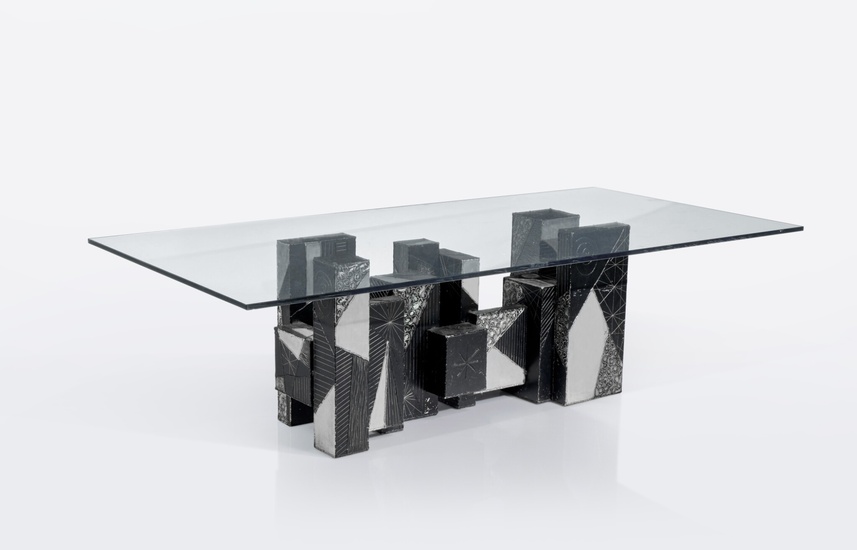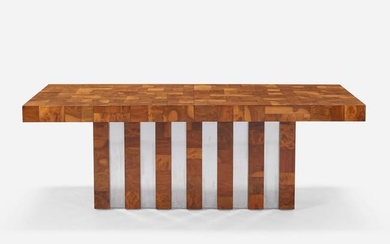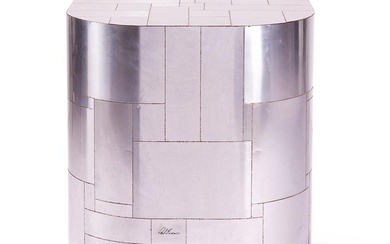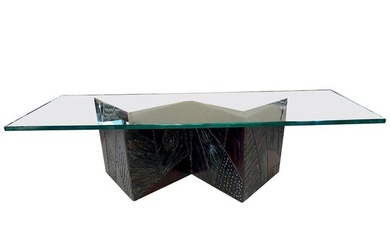Paul Evans "Argente Skyline" Dining Table
Paul Evans
"Argente Skyline" Dining Table
1973
produced by Paul Evans Studio, Plumsteadville, Pennsylvania
welded and dye-painted aluminum, glass
signed Paul Evans and dated 73
27 x 96 x 48 in. (68.6 x 243.8 x 121.9 cm)
Condition Report:
Overall in very good condition. Characteristic of Evans’ “Argente” series, this table presents with a variety of abstract motifs, surface treatments and dynamic contrasts between black and reflective silver. The metal surfaces overall present with irregularities and great texture which are inherent to the artist's practice. The metal and inked surfaces present with faint scattered scratches, scuffing and small indentations consistent with gentle handling, as well as instances of oxidation and minimal tarnish consistent with age. The inked surfaces with areas of minute loss, consistent with age and use. The tops of three of the cubic elements with two small protective felt pads each, measuring approximately 3/8 in. in diameter and not visually distracting.
The top of one element with one small protective felt pad and residue from another.
The glass presents in excellent overall condition with very small surface scratches and soiling throughout as well as two corners with one small chip each, the largest measuring 1/2 in. diameter. The glass with five slightly more pronounced scratches to the top surface, the largest measuring approximately 11 in. long.
Catalogue Note:
The Paul Evans Argente Series
At the peak of his career, Paul Evans introduced the remarkable "Argente" series which is an amalgamation of the most exceptional qualities from his celebrated body of work. This series emerged during Evans' experimental and collaborative phase and prior to his more widely accessible and mass-produced furniture lines. The fabrication process was difficult and labor intensive resulting in a very limited production. With its captivating fusion of artistic flair and practicality, the "Argente" series stands as a testament to Evans' innovative prowess, and is perhaps the most graphic and ambitious series of his prolific career.
In 1956, after attending a series of schools and apprenticing in the art of metalsmithing, Evans began collaborating with fellow furniture designer Philip Lloyd Powell, selling collaborative designs in a shared showroom in New Hope, Pennsylvania. By 1966 Evans shifted his practice to focus on merging craft methods with industrial techniques to produce goods accessible to a larger audience. He had been selling his personal work separately since 1952, exhibiting in New York City and designing product lines for companies like Directional. Although Powell left for three years to travel abroad, he and Evans would continue to collaborate throughout their careers.
During the 1960s, Evans embarked on commissions, creating pioneering, handcrafted furniture. He pushed artistic boundaries, experimenting with techniques such as expressive welding and 'sculpted bronze'—a process involving custom epoxy that was shaped and sandblasted to yield highly textural surfaces. The Paul Evans Studio became an experimental factory of craft production, revolutionizing the furniture industry while fulfilling both custom orders and producing mass-marketed pieces.
In the mid-1960s, indicative of his inventive creativity, Evans developed a unique process using aluminum sheeting. He cut the metal into shapes and applied ink to create a darkened effect. The sheets were then meticulously sanded, buffed and torched, resulting in a captivating interplay of tones and surface textures. Evans employed this technique first in the creation of three-dimensional artworks, such as his sculpture titled Pinwheel, which illustrates his mastery of the material and his predilection for expressive forms. From 1965 to 1972, Evans further utilized this process to create a distinctive line of furniture titled “Argente,” the Latin word for silver. These visual effects were enhanced by the application of a distinct geometric pattern, showcasing layered shapes such as zig-zags, sunbursts, and other intricate motifs. The construction of these pieces was a labor-intensive undertaking that involved welding aluminum, a challenging endeavor. The style deliberately incorporated exposed nail heads and, in opposition to popular Modernist furniture of the time period, displayed characteristics of being handmade by artisans. This series represented a convergence of the geometry and artistry of Evans' earlier welded steel designs with a more contemporary material and streamlined aesthetic.
In reference to the ingenuity of his use of the material, Evans stated, “This is a whole new approach to aluminum and these pieces I created for America House are my first approach to this metal which has a great future…”
It would prove to be a clear precursor to the lines produced by Evans in the 1970s, such as the widely successful “Chrome” (or “Cityscape”) series where polished metals and burlwood were applied to surfaces in a...
View it on
Estimate
Time, Location
Auction House
Paul Evans
"Argente Skyline" Dining Table
1973
produced by Paul Evans Studio, Plumsteadville, Pennsylvania
welded and dye-painted aluminum, glass
signed Paul Evans and dated 73
27 x 96 x 48 in. (68.6 x 243.8 x 121.9 cm)
Condition Report:
Overall in very good condition. Characteristic of Evans’ “Argente” series, this table presents with a variety of abstract motifs, surface treatments and dynamic contrasts between black and reflective silver. The metal surfaces overall present with irregularities and great texture which are inherent to the artist's practice. The metal and inked surfaces present with faint scattered scratches, scuffing and small indentations consistent with gentle handling, as well as instances of oxidation and minimal tarnish consistent with age. The inked surfaces with areas of minute loss, consistent with age and use. The tops of three of the cubic elements with two small protective felt pads each, measuring approximately 3/8 in. in diameter and not visually distracting.
The top of one element with one small protective felt pad and residue from another.
The glass presents in excellent overall condition with very small surface scratches and soiling throughout as well as two corners with one small chip each, the largest measuring 1/2 in. diameter. The glass with five slightly more pronounced scratches to the top surface, the largest measuring approximately 11 in. long.
Catalogue Note:
The Paul Evans Argente Series
At the peak of his career, Paul Evans introduced the remarkable "Argente" series which is an amalgamation of the most exceptional qualities from his celebrated body of work. This series emerged during Evans' experimental and collaborative phase and prior to his more widely accessible and mass-produced furniture lines. The fabrication process was difficult and labor intensive resulting in a very limited production. With its captivating fusion of artistic flair and practicality, the "Argente" series stands as a testament to Evans' innovative prowess, and is perhaps the most graphic and ambitious series of his prolific career.
In 1956, after attending a series of schools and apprenticing in the art of metalsmithing, Evans began collaborating with fellow furniture designer Philip Lloyd Powell, selling collaborative designs in a shared showroom in New Hope, Pennsylvania. By 1966 Evans shifted his practice to focus on merging craft methods with industrial techniques to produce goods accessible to a larger audience. He had been selling his personal work separately since 1952, exhibiting in New York City and designing product lines for companies like Directional. Although Powell left for three years to travel abroad, he and Evans would continue to collaborate throughout their careers.
During the 1960s, Evans embarked on commissions, creating pioneering, handcrafted furniture. He pushed artistic boundaries, experimenting with techniques such as expressive welding and 'sculpted bronze'—a process involving custom epoxy that was shaped and sandblasted to yield highly textural surfaces. The Paul Evans Studio became an experimental factory of craft production, revolutionizing the furniture industry while fulfilling both custom orders and producing mass-marketed pieces.
In the mid-1960s, indicative of his inventive creativity, Evans developed a unique process using aluminum sheeting. He cut the metal into shapes and applied ink to create a darkened effect. The sheets were then meticulously sanded, buffed and torched, resulting in a captivating interplay of tones and surface textures. Evans employed this technique first in the creation of three-dimensional artworks, such as his sculpture titled Pinwheel, which illustrates his mastery of the material and his predilection for expressive forms. From 1965 to 1972, Evans further utilized this process to create a distinctive line of furniture titled “Argente,” the Latin word for silver. These visual effects were enhanced by the application of a distinct geometric pattern, showcasing layered shapes such as zig-zags, sunbursts, and other intricate motifs. The construction of these pieces was a labor-intensive undertaking that involved welding aluminum, a challenging endeavor. The style deliberately incorporated exposed nail heads and, in opposition to popular Modernist furniture of the time period, displayed characteristics of being handmade by artisans. This series represented a convergence of the geometry and artistry of Evans' earlier welded steel designs with a more contemporary material and streamlined aesthetic.
In reference to the ingenuity of his use of the material, Evans stated, “This is a whole new approach to aluminum and these pieces I created for America House are my first approach to this metal which has a great future…”
It would prove to be a clear precursor to the lines produced by Evans in the 1970s, such as the widely successful “Chrome” (or “Cityscape”) series where polished metals and burlwood were applied to surfaces in a...







